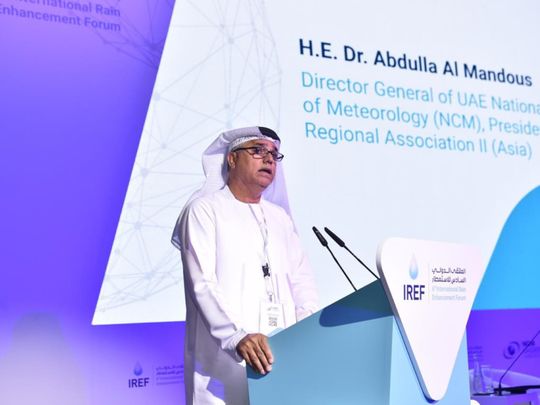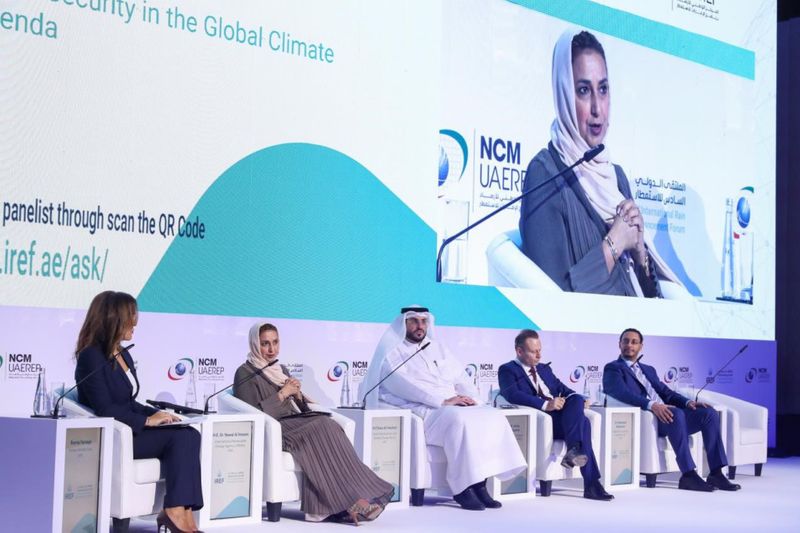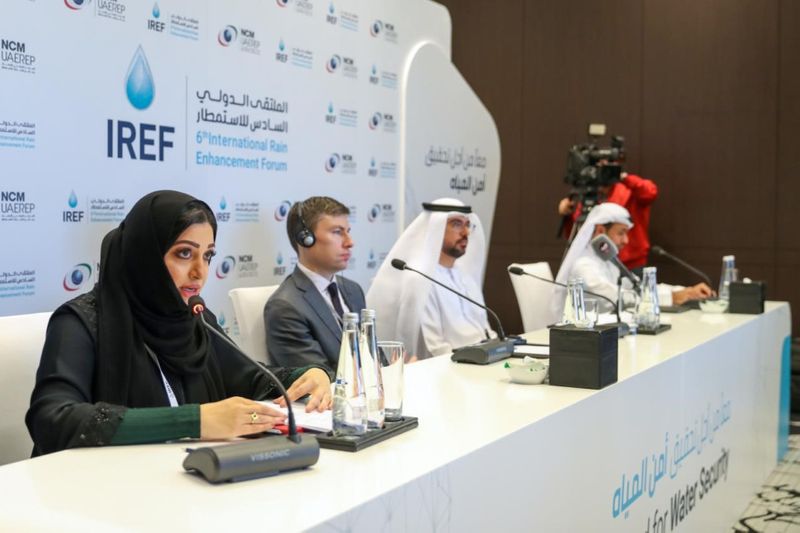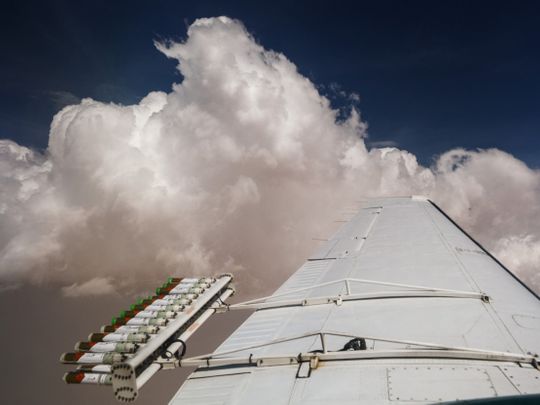UAE performs around 1,000 hours of cloud seeding a year to enhance rainfall

Image Credit: Supplied
Abu Dhabi: The UAE performs about 1,000 hours of cloud seeding on average each year in order to supplement the minimal rainfall it receives, it was revealed on Tuesday on the sidelines of International Rain Enhancement Forum in Abu Dhabi.
The UAE has so far invested $18 million (around Dh66million) in rain enhancement projects, top meteorological experts said.
The Forum is held under the patronage of His Highness Sheikh Mansour Bin Zayed Al Nahyan, Deputy Prime Minister and Minister of Presidential Court.
Sheikh Mansour, in a speech delivered on his behalf by Dr Abdulla Al Mandous, the director-general of the National Center of Meteorology (NCM), said: “The UAE continues to deliver on its commitment to adopting innovation as a core component of in its government, scientific and economic agenda in support of global environmental goals, particularly those related to climate change and water security. As our country prepares to host key decision and policy makers at 28th session of the Conference of the Parties [COP 28], we have recently launched several ambitious initiatives, programmes and strategies that will reinforce the UAE’s status as one of the most active and committed countries to the principles of environmental sustainability.”
The speech added: “The UAE Research Programme for Rain Enhancement Science is a noteworthy example of the UAE’s aspirations to become a global hub for advancing the global water security agenda, as evidenced by the achievements made by the programme’s awardee projects over its past four cycles.
“As we embark on a new phase of the Programme’s journey, the advancement of science, technology and operational aspects of rain enhancement research has become our collective responsibility. To achieve this goal, we are determined to work closely with top scientific institutions and renowned researchers and enable them to find innovative solutions that enhance our water resources in a sustainable manner at a time of massive urbanisation that poses various challenges and places increasing pressure on our limited resources.”

Image Credit: Supplied
‘Weather factory’
Dr Al Mandous, in his own remarks, said: “The sixth edition of the Forum serves as an important platform offered by the UAE to the world to achieve the security and sustainability of water supplies and to tackle the challenges of climate change. As the preparation for COP28 are in full swing, we are keen to be part of this momentum by exploring innovative solutions for rain enhancement and by finding ways to accelerate the transition from research to real applications. The ‘Emirates Weather Enhancement Factory’ is a perfect example of such applications.”
Cloud seeding
As recently as Tuesday, cloud seeding was carried out over the northern emirates, where there were cumulus cloud formations, said Omar Al Yazeedi, deputy director-general at the National Centre of Meteorology (NCM).
“On average, the UAE receives just 79 millimetres of rainfall in a year, although this can sometimes increase to up to 140 millimetres during a particular weather event on storm. So there is a lot of work that still has to be done in order to ensure water security, and cloud seeding is just one of the ways the UAE works to ensure water security [as part of one of the world’s most arid regions],” Al Yazeedi told Gulf News.
In contrast, the globally averaged annual precipitation over land is about 700 millimetres.
Water security challenge
Al Yazeedi was speaking on the sidelines of the Forum, where scientists and other experts met with officials to discuss the latest advances in the sector.

Image Credit: Supplied
The UAE views water security as one of its main challenges, with the water shortage being compounded by declining groundwater reserves, pollution, climate change, and rapid population growth. In addition to a host of other efforts, including initiatives to reduce water consumption and increase the efficiency and sustainability of desalination, the nation has been carrying out cloud seeding operations since the late 1980s.
Al Yazeedi said earlier that an operation in a clear atmosphere increases rainfall from gathered clouds by up to 35 per cent.
Rain enhancement
Meanwhile, the UAE Rain Enhancement Programme (UAEREP) acts as a global platform launched by the NCM to tackle pressing global water and sustainability issues. The programme launched its fifth cycle at the Forum, with awardees to be announced in January 2024.
Dr Alya Al Mazroui, UAEREP director at the NCM, said: “UAEREP has so far provided more than $18 million (around Dh66 million) in funding to 11 projects that combine the expertise of 188 researchers from 31 institutions. In this cycle, we are excited to support game-changing projects focussing on cloud formation and rain enhancement. We will seek projects with a high level of technological readiness that can deliver clear operational improvements with tangible outcomes, and we will welcome innovator and research applications on stimulating convection in the atmosphere to enhance cloud formation and precipitation.”
The programme offers a grant of up to $1.5 Million (around Dh5.51 million) distributed over three years for each winning research proposal. Registration of proposals for is open till March 9 and pre-proposals should be submitted by March 16.
Thus far, UAEREP awardee projects have yielded new models and data analyses in rain and precipitation science. One of the projects awarded in the first cycle has helped develop nanomaterial aerosols for cloud seeding that can significantly increase precipitation in arid climates with low humidity, and Dr Al Mazroui said the NCM had recently increased its production of these flares at their facility.
Artificial clouds?
Another exciting project also was also trailed last February to test the possibility of artificial cloud formation. These were the second field trials for the project, and were conducted on the UAE’s highest peak – Jebel Jais – in Ras Al Khaimah, led by Dr Ali Abshaev, UAEREP third cycle awardee and senior researcher at the Hail Suppression Research Centre in Russia.
“To put it simply, it involved an upside down engine spraying solutions into the atmosphere to see if, under the right climactic conditions – temperature, pressure, humidity – we can form cloud that can be used for rainfall on demand. It looked promising and it seemed as though there were interesting initial formations of what would be artificial clouds,” Dr Steven Griffiths, senior vice president of research and development at Khalifa University, said.
Other projects
There are also two other drone-based solutions that are being tested further as means to enhance cloud seeding operations, including one that attempts to detect ‘seedable’ clouds and then deliver seeding material to them, and another that detects and deploys electric charges to clouds to enhance rainfall.
Numerous other countries and regions around the world carry out cloud seeding, including China, the United States, and India.
“If we are able to advance the scientific knowledge of weather and rainfall – and our numeric weather modelling – then combine it with artificial weather modelling to predict which clouds are seedable, while also developing our drones enough to autonomously deploy them with a novel seeding material, you can have rain where you want it and when you want it. This will help us do work to provide water solutions locally and globally, and this can happen within the next decade, given the pace of platform technology development like AI and nanomaterials,” Dr Griffiths predicted.
How is cloud seeding done in UAE?
When there is a forecast for cumulus clouds – flat-based, puffy clouds that often have water content – the NCM sends out its aircraft from its Al Ain-based hangar for seeding. Al Yazeedi earlier explained that there is usually a very short window for seeding to be effective, ranging from 20 to 30 minutes.
The aircraft fire flares with seeding materials, usually a mixture of salts, into the clouds.
Cumulus clouds, which are common in the UAE, have water in them but the droplets are sometimes too tiny. Seeding materials injected into the clouds help the droplets grow in size, and they collide together to form bigger droplets that are heavier than air, and thus falls as rain. Cloud seeding has also been proven to change the structure of the droplet in the cloud to form bigger droplets which are also better distributed at the base of the cloud.
According to Al Yazeedi, clear air, good updraft (vertical wind energy in the cloud) and a seeding operation in the early stages of cloud formation, help improve the effectiveness of cloud seeding.
Safety first
The weather expert also dismissed claims that cloud seeding activity could be hazardous.
“The amount of salts we use is [minimal]. In terms of size, the clouds that we seed are 100×50 kilometres wide, and at least 18 kilometres from top to base. That’s more than nine times the size of Burj Khalifa. When we inject the cloud seeding salt, it is nothing in amount compared to the composition and concentration of salts in the atmosphere. So there is no side effect of the hygroscopic flares used.
“As for the nanomaterials [that have been developed], the titanium dioxide used in the shell to enhance the effectiveness of seeding is used also in cosmetics, in food colouring, in cakes, and even salad sauces. We are working with nature, not against it. Everything in our operation is environmentally safe,” Al Yazeedi said.
In its latest edition, the event has drawn the participation of 46 speakers and panelists from 18 countries across the world, including Prof Petteri Taalas, Secretary-General, World Meteorological Organisation (WMO) who delivered the opening speech and Mariam Almheiri, UAE Minister of Climate Change and Environment, who addressed the event through her video-recorded remarks.



